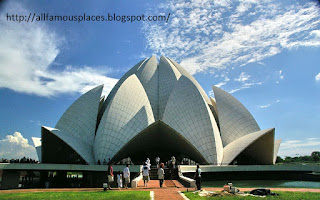The Lotus Temple, situated in New Delhi, India, is a Bahá'í House of Worship finished in 1986. Outstanding for its flowerlike shape, it serves as the Mother Temple of the Indian subcontinent and has turned into a conspicuous fascination in the city. The Lotus Temple has won various building honors and been included in several daily paper and magazine articles. All Bahá'í Houses of Worship, including the Lotus Temple, share certain structural components, some of which are indicated by Bahá'í sacred text. `Abdu'l-Bahá, the child of the author of the religion, stipulated that a vital design character of a House of Worship is a nine-sided round shape.While all current Bahá'í Houses of Worship have a vault, this is not viewed as a crucial piece of their structural planning. Bahá'í sacred writing additionally expresses that no photos, statues or pictures be shown inside of the House of Worship and no lecterns or holy places be joined as an engineering component.
The site is in the town of Bahapur, in the National Capital Territory of Delhi.The auxiliary outline was embraced by the UK firm Flint and Neill. The significant piece of the stores expected to purchase this area was given by Ardishír Rustampúr of Hyderabad, Sindh, who gave his whole life reserve funds for this reason in 1953.The development organization was ECC Construction Group of Larsen & Toubro Limited.A bit of development spending plan was spared and used to manufacture a nursery to concentrate on indigenous plants and blossoms that would be suitable for utilization on the site.
Like all other Bahá'í Houses of Worship, the Lotus Temple is interested in all, paying little respect to religion, or whatever other qualification, as underscored in Bahá'í writings. The Bahá'í laws accentuate that the soul of the House of Worship be that it is a social occasion place where individuals of all religions may love God without denominational restrictions.The Bahá'í laws likewise stipulate that just the blessed sacred writings of the Bahá'í Faith and different religions can be perused or droned inside in any dialect; while readings and supplications to God can be set to music by choirs, no musical instruments can be played inside. Moreover no sermons can be conveyed, and there can be no form.

No comments:
Post a Comment